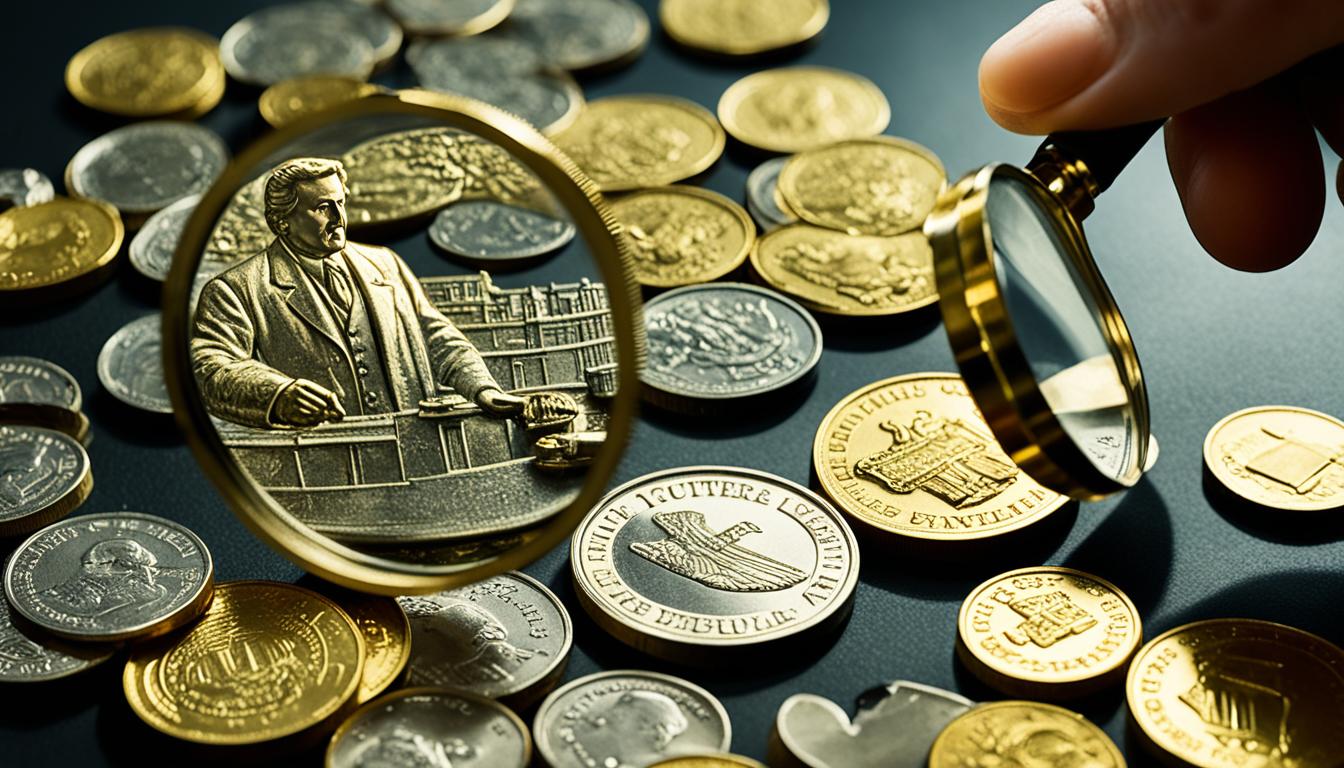Are you aware that the worldwide demand for precious metals is estimated to reach $334 billion by 2028? As investors aim to broaden their portfolios and protect against economic uncertainties, precious metals are increasingly seen as a appealing investment choice. Prior to entering the realm of precious metals, it is vital to consider some key questions that will influence your investment approach and aid in making well-informed decisions.
Key Takeaways:
- Before investing in precious metals, it’s important to ask yourself key questions to guide your investment approach.
- Consider the different forms of precious metal ownership, such as physical, digital, and paper.
- Allocated precious metals provide the highest level of investor safety, while unallocated metals introduce counterparty risk.
- Compare mark-ups among different dealers to ensure you get the best price for your precious metal investments.
- Choose secure storage options and reputable custodians to protect your precious metals.
Physical, Digital, or Paper?
When it comes to investing in precious metals, there are various forms of ownership to consider: physical, digital, and paper. Each has its own advantages and considerations.
Physical Precious Metals
Investing in physical precious metals, such as coins and bars, offers direct ownership and tangible assets. This form of ownership allows investors to have complete control over their investment without any intermediaries or liabilities. Owning physical precious metals provides a sense of security, knowing that you physically possess a valuable asset.
Digital Gold
Another option is investing in digital gold. This involves purchasing digital representations of physical gold, which are backed by actual gold reserves. Digital gold provides the convenience of ownership without the need for physical storage. Investors can buy and sell digital gold through various platforms, enabling easy access to the gold market.
Paper Gold
Alternatively, investors can consider paper gold, which includes gold certificates and futures contracts. Paper gold represents ownership of gold without physically possessing the metal. However, it’s important to note that paper gold may not grant ownership title and can be subject to counterparty risks, especially in case of issuer default.
Investing in physical precious metals offers direct ownership and security, while digital gold provides convenience and accessibility to the gold market. On the other hand, paper gold carries risks associated with counterparty default.
It’s important to carefully evaluate the pros and cons of each form of precious metal ownership before making an investment decision. While physical metal ownership provides direct ownership and peace of mind, digital gold and certain paper gold options offer convenience and accessibility to the market.
It is advisable to invest in physical precious metals or fully-backed physical exchange-traded offerings to ensure direct ownership and security. These options eliminate the counterparty risks associated with paper gold investments.
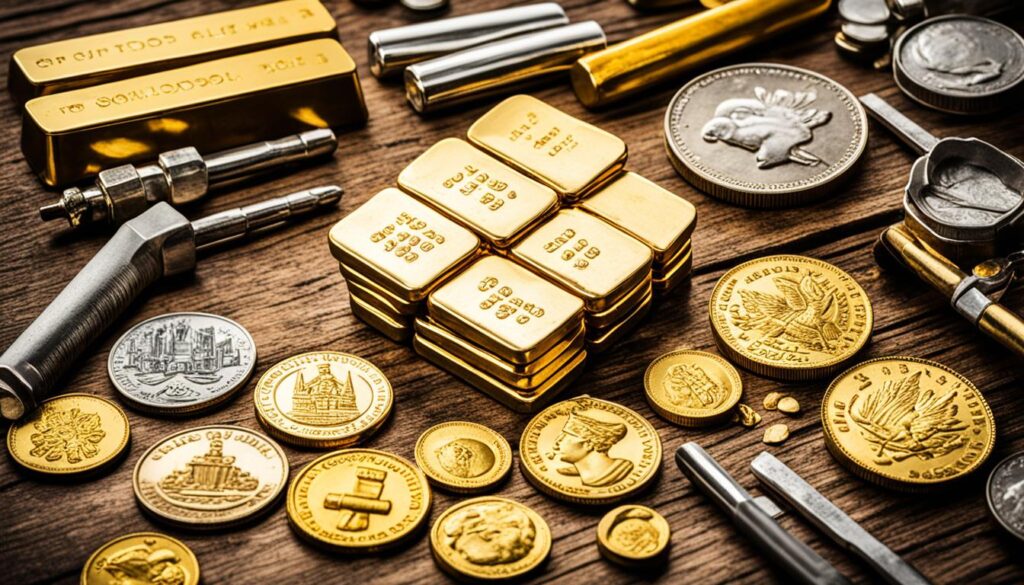
Comparison of Precious Metal Ownership Options
| Form of Ownership | Pros | Cons |
|---|---|---|
| Physical Precious Metals | Direct ownership Tangible, secure assets |
Requires storage May have higher upfront costs |
| Digital Gold | Convenient and accessible No storage required |
Indirect ownership Dependent on digital platform |
| Paper Gold | Potential for liquidity Accessible through financial markets |
Counterparty risk No direct ownership title |
Allocated or Unallocated Metals?
When considering investing in precious metals, one of the key decisions is whether to opt for allocated or unallocated metals. Each choice carries its own significance, benefits, and risks, particularly in terms of counterparty risk.
Allocated precious metals offer the highest degree of investor safety. In this form of ownership, the metals are segregated and unencumbered, and the investor is granted ownership title. This means that the metals are specifically allocated to the investor and held on their behalf, ensuring full ownership. By having allocated metals, investors can minimize their exposure to counterparty risk.
Unallocated precious metals, on the other hand, introduce counterparty risk as the ownership title is not secured by the holder. In certain situations, investments in unallocated metals may exceed the total amount of underlying metal, potentially making investors unsecured creditors in the case of issuer insolvency or bankruptcy. This emphasizes the importance of carefully considering the risks associated with unallocated metals.
To grasp the significance of allocated precious metals, it’s important to understand that they cannot be lent or leased to third parties. This further reduces counterparty risk and provides additional security for investors. By choosing to invest in fully allocated precious metals, investors can ensure that their investments are safeguarded and protected.
An appropriate analogy to help illustrate the difference between allocated and unallocated metals is to consider a safe deposit box. Allocated metals are like having your own personal, dedicated safe deposit box, where the metals are allocated specifically to you. Unallocated metals, on the other hand, are like sharing a safe deposit box with multiple parties, where ownership can be less clear and more complicated.
The benefits of allocated metals stem from the direct ownership and the security it provides. Since the metals are held separately and cannot be used by anyone else, investors have peace of mind knowing that their ownership rights are protected. Allocated metals also offer transparency and clarity in terms of ownership, which can be reassuring for investors seeking stability and reliability.
While allocated metals offer numerous advantages, it’s essential to understand the risks of unallocated metals. The lack of specific ownership and the potential for investments to exceed the underlying metal create additional uncertainties. In the event of issuer insolvency or bankruptcy, investors may find themselves in a vulnerable position as unsecured creditors. This highlights the importance of carefully assessing the counterparty risk associated with unallocated metals.

Investors who prioritize security and mitigating counterparty risk should consider investing in fully allocated precious metals. By having direct ownership and knowing that the metals are allocated specifically to them, investors can enjoy the peace of mind and stability that come with this form of investment. Avoiding the risks associated with unallocated metals can help safeguard investments and provide a solid foundation for a precious metals portfolio.
When making investment decisions, it is crucial to carefully weigh the pros and cons of allocated and unallocated metals and choose an approach that aligns with your investment goals and risk tolerance.
Mark-Up to Spot Metals Prices
When purchasing precious metals in coin and bar form, there are generally mark-ups ranging from 2% to 8% over spot prices. It is essential to compare mark-ups among different dealers to get the best price.
Buying precious metals at a favorable mark-up enables investors to optimize their investment by minimizing the initial cost. By researching and comparing mark-ups from various dealers or platforms, investors can ensure that they are getting the most competitive prices for their precious metal purchases.
Comparing Mark-Ups for Precious Metals
“When it comes to buying precious metals, it’s important to shop around and compare mark-ups. The mark-up percentage can vary significantly among different dealers or investment platforms. By comparing mark-ups, investors can find better deals and potentially save money on their precious metal purchases.”
By conducting thorough research and consulting reputable sources, investors can identify the dealers or platforms offering competitive mark-ups and make informed decisions regarding their precious metal purchases.
Total Cost of Ownership versus Management Fees
Additionally, if you plan to hold precious metals for only a few years, it’s important to consider the total mark-up and mark-down costs versus the estimated management fees for owning an exchange-traded fund (ETF) or closed-end fund.
When evaluating the cost-effectiveness of investing in precious metals, it’s crucial to consider not only the mark-up at the time of purchase but also any potential mark-downs when selling or exchanging the metal.
On the other hand, owning precious metals through ETFs or closed-end funds may entail management fees. These fees cover the costs associated with managing and operating the investment vehicle. Investors should compare these management fees with the total mark-up and mark-down costs associated with owning physical precious metals to determine the most cost-effective investment option.
Comparing Total Cost of Ownership
To determine the total cost of ownership, investors should consider the estimated mark-up when purchasing physical precious metals, any mark-downs that may occur when selling or exchanging the metal, as well as the management fees associated with ETFs or closed-end funds.
Evaluating the total cost of ownership provides investors with a comprehensive view of the expenses associated with different investment options. By comparing the total cost of ownership with the management fees of ETFs or closed-end funds, investors can make informed decisions that align with their investment goals and financial circumstances.
Ultimately, considering both mark-up comparisons and the total cost of ownership versus management fees allows investors to make more prudent and cost-effective choices when investing in precious metals.
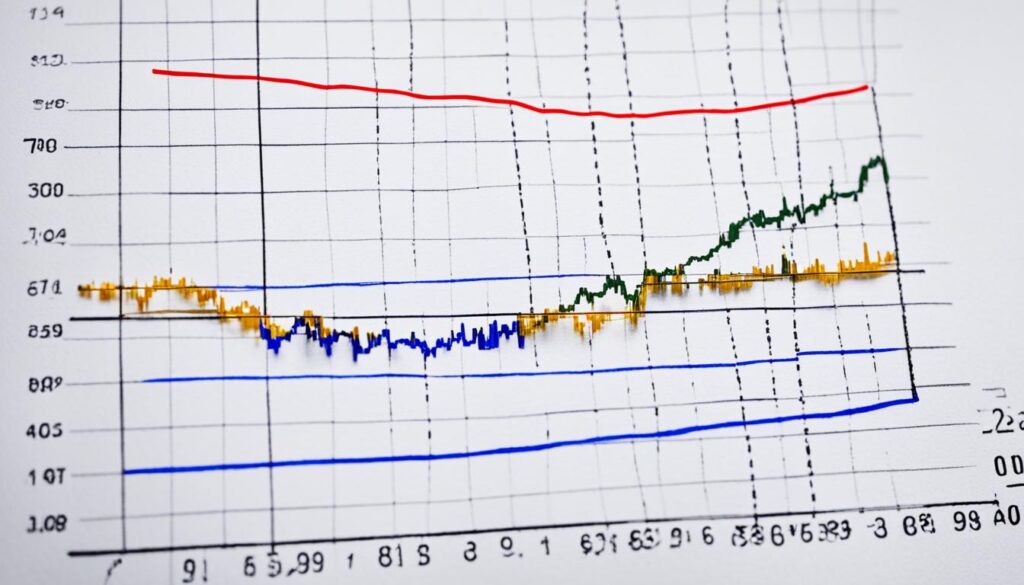
Storage of Precious Metals
Storing precious metals securely is essential to mitigate risk and protect your investments. Thankfully, there are numerous reputable storage providers that offer secure and insured storage solutions for precious metals.
When selecting a storage facility, it’s important to prioritize trust and reputation. Look for established providers with a track record of excellence in secure storage. These reputable storage providers have stringent security measures in place to ensure the safety of your precious metals.
For investors considering ETFs and closed-end funds that store underlying metal at bullion banks, it’s crucial to be mindful of the storage custodian’s affiliation. Avoid storage custodians that are subsidiaries of levered financial institutions, as this introduces an additional counterparty risk.
“Investors must prioritize the secure storage of precious metals to safeguard their investments. Reputable storage providers offer insured solutions, ensuring peace of mind for investors.”
Benefits of Secure Storage
Opting for secure storage of precious metals provides several advantages:
- Protection against theft, damage, and loss
- Insurance coverage to mitigate financial risks
- Professional handling and storage facilities designed for precious metals
- Verification of authenticity and purity
- Access to audit reports and third-party verification for transparency
The Role of Reputable Storage Providers
Reputable storage providers play a crucial role in safeguarding your precious metals. Their expertise, experience, and commitment to security ensure that your investments are protected.
These providers typically employ state-of-the-art security systems, including 24/7 monitoring, secure vaults, and advanced access controls. They prioritize confidentiality and maintain strict privacy protocols, ensuring that your ownership remains confidential.
“Investors should choose storage providers with an established reputation for secure storage. Reputable providers have thorough security measures in place to protect precious metals and maintain client privacy.”
Counterparty Risk and Storage Custodians
Counterparty risk refers to the potential risk associated with the failure of a storage custodian or financial institution holding your precious metals. To mitigate this risk, it is essential to choose storage custodians that have no affiliations with levered financial institutions.
By selecting storage custodians independent of levered financial institutions, investors can reduce the exposure to counterparty risk and increase the security of their precious metal investments.
Sample Table: Reputable Storage Providers
| Storage Provider | Location | Features |
|---|---|---|
| Brink’s | New York, NY | Global leader in secure logistics and storage solutions |
| Malca-Amit | Hong Kong | Specializes in secure storage for high-value assets |
| Loomis International | London, UK | Offers customized secure storage and transportation services |
“Investors should carefully assess storage providers’ reputation, security measures, and accessibility for their precious metals. Reputable storage providers, such as Brink’s, Malca-Amit, and Loomis International, offer top-tier facilities and services for secure storage.”
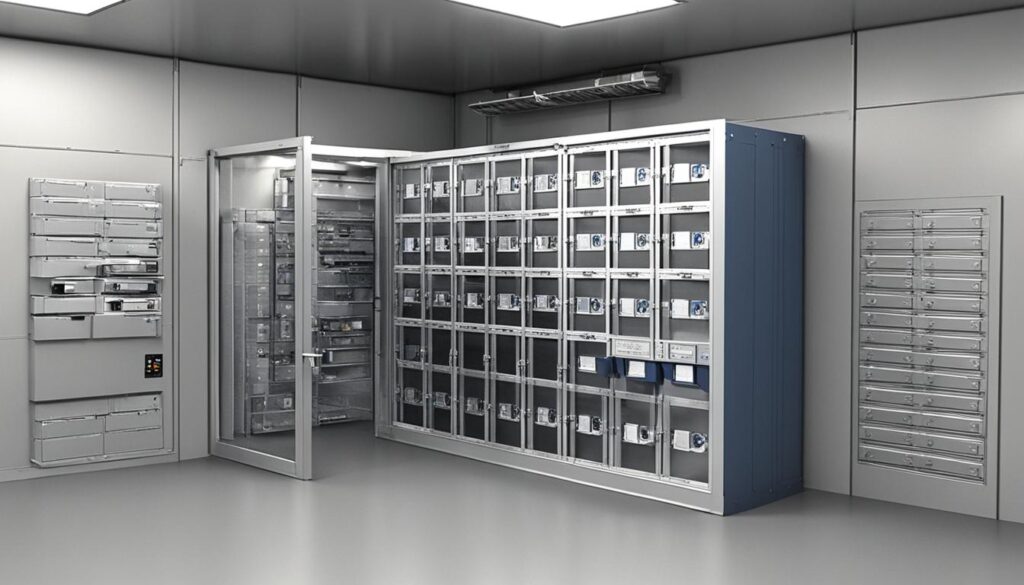
Taking Delivery of Precious Metals
When considering investments in precious metals, one crucial factor to take into account is the ease of physical delivery. Direct investment in coins and bars allows for straightforward physical delivery, providing you with tangible ownership of the precious metals. However, it’s important to weigh the advantages and trade-offs associated with this option.
While physical delivery offers the benefit of direct ownership, it also comes with certain considerations. One trade-off is the mark-ups associated with purchasing coins and bars. When acquiring these physical assets, there are generally mark-ups ranging from 2% to 8% over spot prices. Comparing mark-ups among different dealers can help you find the best price for your investment.
Another aspect to consider is the need to arrange for secure storage for your precious metals. Unlike digital or paper investments, physical assets require a suitable storage solution to ensure their safety. It’s crucial to select reputable and secure storage providers to safeguard your valuable investment.
It’s worth noting that most prominent bullion ETFs do not permit the average investor to take physical delivery of the precious metals. This option is often reserved for limited groups. However, some closed-end funds do allow investors to take physical delivery, providing an alternative for those who prefer to have direct ownership of the underlying metal.
The ability to take physical delivery of your precious metals is an important feature to consider when choosing a bullion investment vehicle. If physical possession is a priority for you, it’s advisable to explore investment options that offer this flexibility. For example, precious metal dealers like JM Bullion provide customers with the opportunity to purchase and take possession of gold, silver, and other metals directly. It’s worth reading a JM Bullion review to better understand the quality of their service, shipping options, and overall customer satisfaction. Ultimately, having the choice of physical delivery can help investors feel more secure in their ownership of tangible assets.
“Investors who value the tangibility and security of physically owning precious metals may opt for direct investment in coins and bars with the ease of physical delivery.”
To better understand the options available for physical delivery of precious metals, refer to the table below:
| Physical Delivery Options | Ease of Taking Delivery |
|---|---|
| Direct Investment in Coins and Bars | Ease of physical delivery, but requires storage arrangements |
| Bullion ETFs | Limited or no option for physical delivery |
| Closed-End Funds | Some funds allow physical delivery |

Ongoing Costs of Precious Metals Ownership
When it comes to owning physical precious metals, there are ongoing costs that investors need to consider. These costs include insurance and storage fees, which are essential for safeguarding your valuable assets.
Insurance is crucial to protect your investment in case of theft, damage, or other unfortunate events. While the cost of insurance may vary depending on the value of your precious metals and the level of coverage you choose, it is a necessary expense to ensure peace of mind and financial protection.
Storage fees are another factor to consider when owning physical precious metals. Storing your metals securely is essential to prevent loss or theft. There are reputable storage providers that offer secure storage solutions specifically designed for precious metals. These providers often charge a fee for their services, which is typically based on the size and value of your holdings.
Additionally, if you prefer to invest in precious metals through exchange-traded funds (ETFs) or closed-end funds, it’s important to be aware of the annual management fees associated with these investment vehicles. These fees cover the costs of managing the fund and providing a profit for the management company. Comparing management fees among different funds can help you determine the most cost-effective option.
Considering the costs of owning physical precious metals, insurance and storage fees, as well as the management fees of ETFs and closed-end funds, is essential for making informed investment decisions. It’s important to evaluate the overall value of each investment option by assessing the associated costs, features, and risks.
By being aware of these ongoing costs, investors can better plan and manage their precious metal investments, maximizing their potential returns while mitigating any unnecessary expenses.
Source: Image source: https://seowriting.ai/32_6.png
Liquidity of Precious Metal Investments
While many investors view precious metals as a long-term investment, there may arise situations that necessitate short-term liquidation. When it comes to selling coins and bars, the process can be cumbersome, requiring you to find potential buyers and negotiate prices. This lack of convenience can pose challenges, especially when time is of the essence.
However, there is an alternative solution that provides greater convenience and liquidity for selling your precious metal investments – Exchange-Traded Funds (ETFs) and closed-end funds. These investment vehicles trade on exchanges, allowing you to buy and sell them throughout the trading day, just like stocks.
The ability to trade ETFs and closed-end funds provides a significant advantage over physical ownership of precious metal assets. Instead of looking for individual buyers and engaging in time-consuming transactions, you can simply place a sell order and take advantage of the dynamic nature of the stock market. This convenience allows you to respond quickly to changing market conditions and easily liquidate your investment to access funds when needed.
Moreover, the settlement period for ETFs and closed-end funds is typically three business days after the sell order is executed. This relatively short period ensures that you can swiftly access the proceeds from your sale and utilize them as required. This streamlined process eliminates the delays associated with selling physical precious metals.
Overall, the liquidity of precious metal investments can greatly impact your investment strategy. While physical ownership has its merits, ETFs and closed-end funds offer unparalleled convenience and flexibility when it comes to selling your investment. Whether you need to access funds quickly or respond to market opportunities, these investment vehicles provide a seamless and efficient solution.
“Investors can enjoy the convenience of buying and selling precious metal investments through ETFs and closed-end funds, avoiding the complexities of selling physical coins and bars.”
Investing in precious metals should always be approached with careful consideration and a comprehensive understanding of the various options available. By weighing the liquidity, convenience, and settlement period of ETFs and closed-end funds against the challenges of selling physical metals, investors can make well-informed decisions that align with their financial goals and objectives.
Summary of Key Points:
- Liquidity of precious metal investments is crucial for short-term liquidation needs.
- Selling coins and bars can be cumbersome and time-consuming.
- ETFs and closed-end funds offer convenience and can be bought and sold throughout the trading day.
- The settlement period for ETFs and closed-end funds is typically three business days.
- Investors can access the proceeds quickly, allowing for greater financial flexibility.
Comparison of Liquidity and Convenience
| Investment Type | Liquidity | Convenience |
|---|---|---|
| Physical Precious Metals | Low | Low |
| ETFs and Closed-End Funds | High | High |
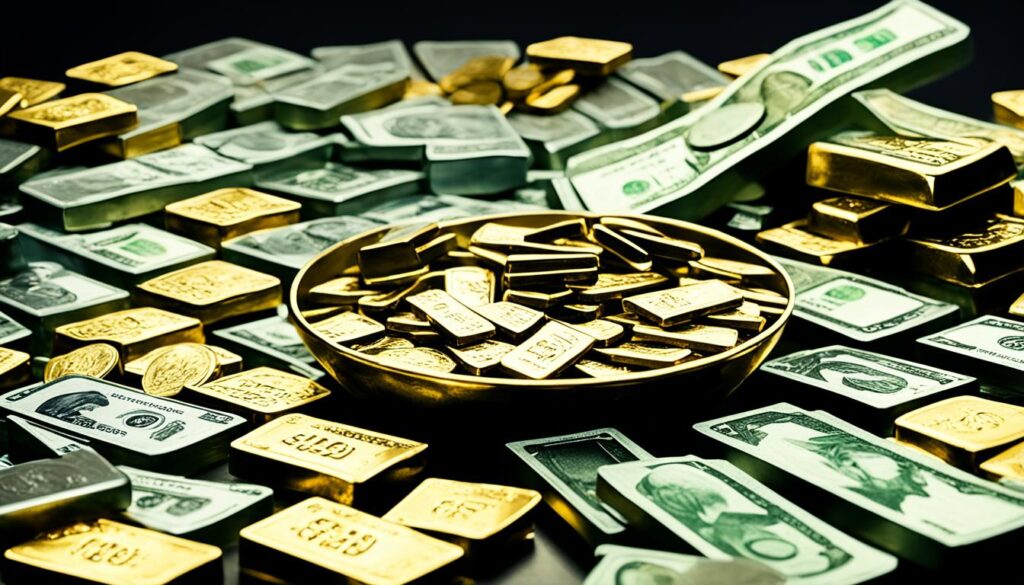
Conclusion
Investing in precious metals can be a strategic and valuable addition to an investment portfolio. Concluding thoughts on investing in precious metals involve carefully considering key aspects such as the form of ownership, costs, storage, and liquidity. By asking the right questions and conducting thorough research, investors can make informed decisions and mitigate risks when investing in precious metals.
One of the key considerations is finding a suitable form of ownership that aligns with your goals and risk tolerance. Whether it’s physical precious metals, digital gold, or paper gold, each option comes with its own benefits and risks. Additionally, considering the costs and mark-ups associated with purchasing precious metals can help determine the most cost-effective investment option.
Furthermore, storage and liquidity play crucial roles in the decision-making process. Selecting a reputable storage provider to ensure the security of your investments is essential. Moreover, assessing the ease of taking physical delivery and the convenience of selling your investment can provide valuable insights into the liquidity of your precious metal investments.
In conclusion, investing in precious metals requires careful thought and consideration. It is advisable to consult with licensed financial professionals to assess if investing in precious metals aligns with your financial goals and current situation. By keeping these key considerations in mind, investors can navigate the precious metals market with confidence and maximize the potential benefits of this asset class.

